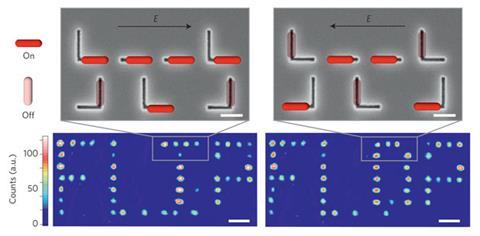Information can be rapidly stored and retrieved from single colloidal particles using light and electricity
Scientists in Switzerland have developed a way to quickly and reliably store, read, erase and rewrite information using colloidal nanoparticles. They say the finding could make fluid phase computing an attainable goal in the not too distant future.
While powerful computers have been developed in the solid state, the ability to perform computational operations in a fluid has remained relatively unexplored. Developing ‘wet’ computers could open up new application areas in environments where current technologies don’t work. Devices that can switch between two states (on and off, or one and zero) are essential components in digital information. Single colloidal particles have interesting physical properties that could be exploited in digital information, but until now there was no way to manipulate and control them in a practicable fashion.
Madhavi Krishnan from the University of Zurich, and colleagues, were able to accurately place a colloidal silver nanorod between two charged surfaces by introducing a cavity in one of the walls. This created a 'potential well' – a region surrounding a local energy minimum – which acted as a trap. ‘If one applies an external force to this system, which we do by applying an electric field or shining light on it, the particle can be forced to be “on” or “off”,’ Krishnan explains. ‘Tailoring the shape of the potential well permits us to have the particle either gate optical signals or store information.’

‘This work shows a clever way to switch the position of an extremely small particle, which has potential implications for data storage, information transfer, and optical displays,’ says Michael Dickey, a chemical engineer at North Carolina State University, US, who studies new routes to control soft materials.
The ‘colloidal bits’ can also be arrayed at high densities. The next step would be to make the single particles interact with each other – a process called cascading. ‘This will hopefully lead us to a demonstration of rudimentary computation in the fluid phase,’ says Krishnan. ‘Cascading single particle logic elements will probably carry the biggest challenge.’












No comments yet